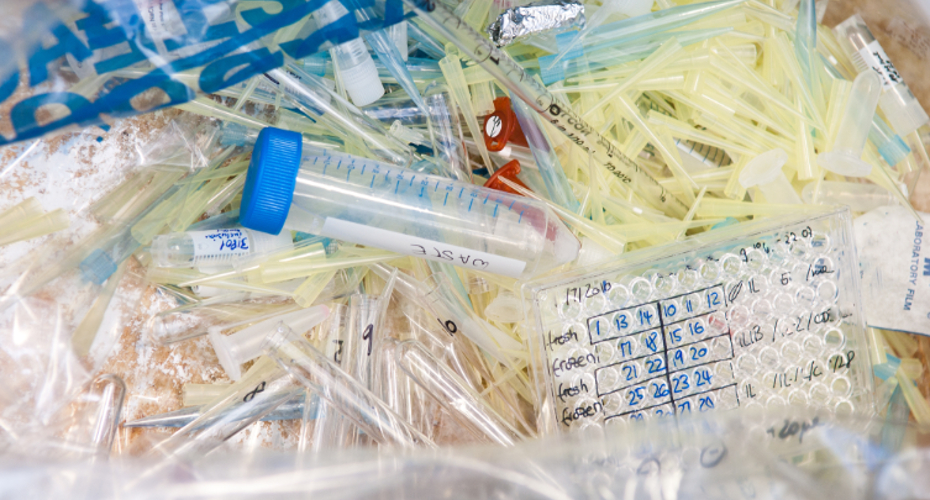Laboratory plastics
When it comes to scientific research, laboratories tend to consume single-use plastics in very high quantities. From plastic petri dishes and a wide array of pipettes and pipette tips, spreaders, inoculation loops, tubes and vials, scientific researchers use and discard numerous types of lab plastics every day.

The use of such equipment is pivotal to making scientific breakthroughs. However, it is also highly detrimental to the environment. In 2015, three researchers at the University of Exeter evaluated the annual plastic waste produced by our labs and estimated that worldwide, lab-based scientific research (biological, medical, agricultural, where plastic use is heaviest) was responsible for producing around 5.5 million tonnes of plastic waste in 2014 alone (see Urbina et al. Labs should cut plastic waste too. Nature 528, 479 (2015)). This is the equivalent of 1.8 per cent of total global plastic waste. It may sound small but as the article says, it equates to “the combined tonnage of 67 cruise liners”!
Given the current global situation, it is more necessary than ever to adopt responsible lab practices to reduce single-use laboratory plastics (SUPs). Our research community is currently looking for ways to reduce SUPs and minimise laboratory waste as much as possible by purchasing plastic items responsibly and focusing on the five R’s of waste management.
The five R’s hierarchy of waste management includes:
Purchase responsibly
- Refuse wasteful ordering and share equipment, chemicals, and other resources
- Consolidate orders with other groups and buy in bulk to reduce packaging and deliveries
- Choose products with reduced plastic content and/or packaging. If you struggle with finding such products, contact your vendors and ask. Your inquiry will show that there is demand for it
- Contact vendors to enquire about take-back schemes for products and packaging. If they don’t already offer them, your inquiry might push it onto their agenda
- Swap to more sustainable brands (e.g., BioEcho products for DNA extraction)
Plan experiments efficiently to minimize plastic usage
- Optimise your experimental design and minimise procedural steps, using as few tubes, tips, plates, etc., as required for your experiment
- Use the smallest size plastic vessels feasible, (e.g., 15 ml Falcon/conical tubes instead of 50 ml)
- Do you need gloves? If so, use the appropriate type for your task. Check the breakthrough safety data for the chemicals you work with, as a thinner glove may be just as safe (and will be more comfortable!)
- Use refill solutions wherever possible. Refill your pipette tip boxes; you can purchase stacked tips for refill, or you can 3D print a re-racking device for bulk tips (search for “Elster” and “pipette tip” on YouTube)
- Replace SUPs with reusable alternatives that can be autoclaved, chemically decontaminated, and washed between uses. The energy used for washing and decontaminating is far less than that to remake, transport and dispose plastic.
- Reusable (silicone) lids can be used to cover Erlenmeyer flasks instead of parafilm or aluminum foil
- Reusable metal inoculating loops or glass beads can be used instead of single-use plastic loops or spreaders
- Use wooden toothpicks for picking bacterial colonies instead of pipette tips
- Purchase bagged Falcon tubes without polystyrene racks and reuse any racks you already have
- Other effective substitutions include glass serological pipettes and universal vials, paper or Pyrex weighing boats, autoclavable reservoirs, etc.
- Reduce the number of suppliers you purchase from where possible, and choose those with the best sustainability credentials
Reuse/repurpose what was considered single use
Direct reuse:
- Use the same pipette tip for plating serial dilution, starting from the highest dilution
- Use the same serological pipette for the same buffer
- Split cells in the same dish
- Send packaging back to suppliers (e.g., NEB polystyrene boxes and ice packs)
- If your suppliers don’t offer to take back their ice packs, reuse them when shipping your own samples and donate them to others
- Repurpose empty chemical containers to hold pipette tip waste and Winchester bottles to contain liquid waste instead of using single-use waste containers and/or plastic bags
Decontaminate, wash, dry, and reuse:
(If decontamination is needed, check which process is suitable for each item: chemical decontamination or autoclaving)
- Glass serological pipettes and glass beads
- Plastic Falcon/conical tubes, reservoirs, cuvettes, and weighing boats (if you still use them!)
- Metal inoculating loops (flame sterilise), scalpels, and cell scrapers
- Nucleic acid extraction columns can be regenerated and used more than once (see link below)
Laboratory processes should be optimised to align with the first four R’s, and only when they have been fully considered, should recycling be used as an option! All hazardous waste and contaminated items must be decontaminated beforehand or excluded from recycling. If you are in doubt or need information regarding this, please look to your technical support team for guidance.
Sort your recyclables in line with local recycling facilities:
- Separate clean cardboard and paper recycling
- Use the relevant plastic recycling stream for consumables packaging (clear plastic wrapping, bubble wrap, etc.) and uncontaminated plastic consumables such as tip boxes and wafers, etc.
Consider using external recycling programs for:
- Uncontaminated disposable gloves, facemasks, visors, and other plastic-based PPE (e.g., ReFactory PPE recycling boxes)
Download:
- Reducing Lab Plastic Waste Poster A3
- Green Lab Consumables Guide PDF
- Choose more sustainable plastic options spreadsheet
Watch:
Get in touch
If you have any comments or recommendations on how to make our labs more sustainable, please contact us and provide your feedback!
LEAF Team
Email: LEAF@exeter.ac.uk



